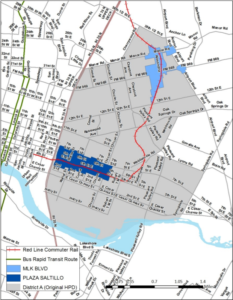After being stymied by Abbott, Council moves ahead on east side housing initiative
Wednesday, December 5, 2018 by
Jack Craver Hobbled by Gov. Greg Abbott in their attempts to create more homestead preservation districts that would set aside tax revenue for affordable housing in gentrifying areas, a number of City Council members are trying to maximize the impact of the city’s existing district.

Council voted in 2007 to create the city’s existing homestead preservation district, which is bordered roughly by Interstate 35 to the west, East Cesar Chavez Street to the south, Martin Luther King Jr. Boulevard to the north, and Airport Boulevard to the east.
The district was inactive until 2015, when Council voted to create a homestead preservation reinvestment zone with the same boundaries. An HPRZ is one of three mechanisms that the state allows cities to use for HPDs to generate funds for affordable housing. Essentially it’s a type of tax increment finance district in which a certain portion of any new tax revenue that is generated from properties in the district is set aside to build housing for those at or below 70 percent of the median family income.
The 2015 ordinance approved by Council set aside 10 percent of new tax revenue (revenue derived from any property value increase since 2015) for housing within the reinvestment zone. After two fiscal years of operation, the district has generated roughly $1.4 million for housing, none of which has been used yet. The ordinance requires that a quarter of the funds be used for housing for those at 30 percent MFI ($18,100/individual, $25,800/family of four), a quarter at 50 percent MFI ($30,100/$43,000) and the rest for those at 70 percent MFI ($42,150/$60,200).
At a Tuesday meeting of the Council Housing and Planning Committee, Council Member Pio Renteria recalled that he and others originally pushed to set aside 20 percent of new revenue from the district for housing. However, Council at the time was planning to create three additional HPRZs and was wary of setting aside too much revenue for one use.
To create the new HPRZs, however, required a change in state law. Although state lawmakers approved the necessary legislation, it was vetoed by Gov. Greg Abbott.
Since there are no new districts in sight, the Housing and Planning Committee voted Tuesday to recommend increasing the set-aside in the existing district to 20 percent. Voting in favor were Renteria and Council members Greg Casar, Ann Kitchen and Alison Alter. Council Member Jimmy Flannigan voted against.
Renteria said that the area in question had been hit the hardest by displacement due to gentrification. There is still opportunity, he said, to put in place housing for those who have been displaced or are vulnerable to displacement.
“You drive down East 12th Street and Manor (Road), there are a lot of empty lots. We could bring people back,” he said.
Flannigan, who has previously expressed reluctance about committing future tax revenues to specific projects, said he was “not ready to support” the proposal, explaining that he was concerned about promoting a concentration of affordable housing in one part of the city.
Casar agreed that the city should strive to disperse affordable housing in different neighborhoods, but argued that the area in question presents a “really unique geographic challenge and pain” as a result of rapid displacement.
Flannigan was unconvinced, but said he appreciated that Council members were trying to get more low-income housing in their districts.
“If we’re all fighting over who gets the most affordable housing,” he said, “then it’s a really good symbol of what this city represents.”
Housing staff will soon begin considering projects that the funds can be used to support and will present possible projects next year. In order to authorize the spending, Council will have to set up a governing HPRZ board that will likely be made up of Council members.
The Austin Monitor’s work is made possible by donations from the community. Though our reporting covers donors from time to time, we are careful to keep business and editorial efforts separate while maintaining transparency. A complete list of donors is available here, and our code of ethics is explained here.
You're a community leader
And we’re honored you look to us for serious, in-depth news. You know a strong community needs local and dedicated watchdog reporting. We’re here for you and that won’t change. Now will you take the powerful next step and support our nonprofit news organization?




